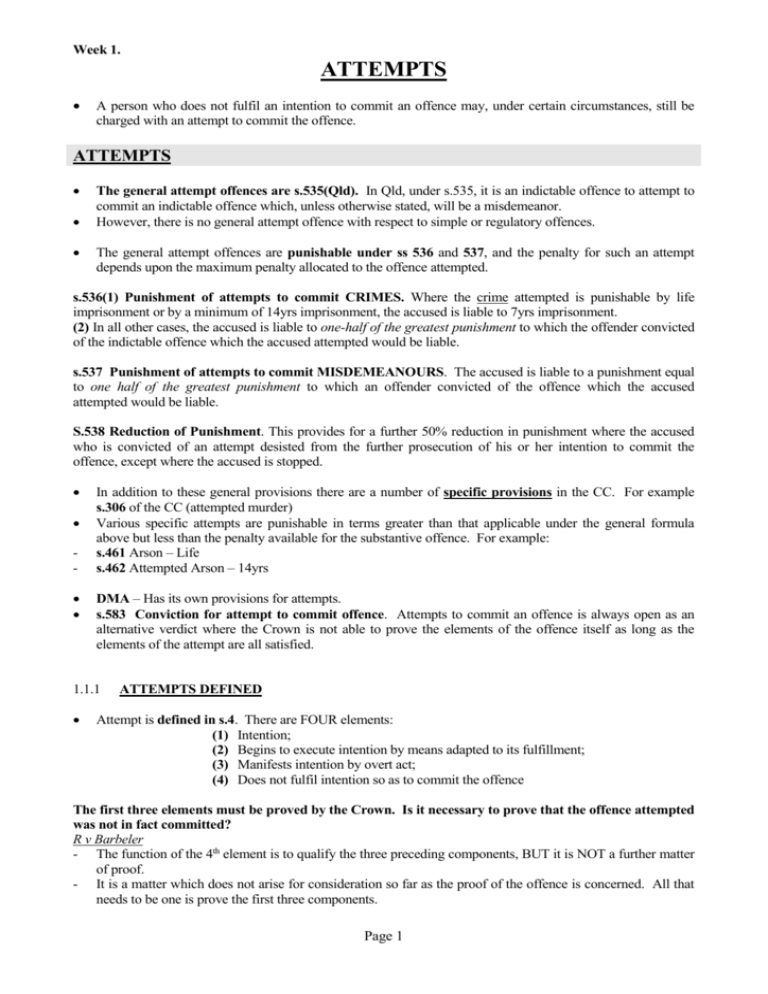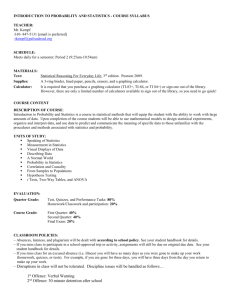O`Halloran v Byrne
advertisement

Week 1. ATTEMPTS A person who does not fulfil an intention to commit an offence may, under certain circumstances, still be charged with an attempt to commit the offence. ATTEMPTS The general attempt offences are s.535(Qld). In Qld, under s.535, it is an indictable offence to attempt to commit an indictable offence which, unless otherwise stated, will be a misdemeanor. However, there is no general attempt offence with respect to simple or regulatory offences. The general attempt offences are punishable under ss 536 and 537, and the penalty for such an attempt depends upon the maximum penalty allocated to the offence attempted. s.536(1) Punishment of attempts to commit CRIMES. Where the crime attempted is punishable by life imprisonment or by a minimum of 14yrs imprisonment, the accused is liable to 7yrs imprisonment. (2) In all other cases, the accused is liable to one-half of the greatest punishment to which the offender convicted of the indictable offence which the accused attempted would be liable. s.537 Punishment of attempts to commit MISDEMEANOURS. The accused is liable to a punishment equal to one half of the greatest punishment to which an offender convicted of the offence which the accused attempted would be liable. S.538 Reduction of Punishment. This provides for a further 50% reduction in punishment where the accused who is convicted of an attempt desisted from the further prosecution of his or her intention to commit the offence, except where the accused is stopped. In addition to these general provisions there are a number of specific provisions in the CC. For example s.306 of the CC (attempted murder) Various specific attempts are punishable in terms greater than that applicable under the general formula above but less than the penalty available for the substantive offence. For example: s.461 Arson – Life s.462 Attempted Arson – 14yrs DMA – Has its own provisions for attempts. s.583 Conviction for attempt to commit offence. Attempts to commit an offence is always open as an alternative verdict where the Crown is not able to prove the elements of the offence itself as long as the elements of the attempt are all satisfied. 1.1.1 ATTEMPTS DEFINED Attempt is defined in s.4. There are FOUR elements: (1) Intention; (2) Begins to execute intention by means adapted to its fulfillment; (3) Manifests intention by overt act; (4) Does not fulfil intention so as to commit the offence The first three elements must be proved by the Crown. Is it necessary to prove that the offence attempted was not in fact committed? R v Barbeler - The function of the 4th element is to qualify the three preceding components, BUT it is NOT a further matter of proof. - It is a matter which does not arise for consideration so far as the proof of the offence is concerned. All that needs to be one is prove the first three components. Page 1 ELEMENT 1: Intention According to the first element in s.4, the accused must have an intention to commit the offence. Such intention is an essential element for all attempts, even where the offence actually attempted does not include the element of intention within it. Thus, although the offence of rape does not contain intent as an element, the offence of attempted rape does. ELEMENT 2: Begins to execute intention by “means adapted to its fulfilment” This ensures that there will be no conviction for an attempt based upon intention alone and will be satisfied if the accused’s conduct is sufficiently proximate to the commission of the intended offence. Various approaches have been suggested to determine the point at which mere preparation ends and the conduct of the accused matures into an attempt. One such approach, referred to as the Last Act Test, required consideration of whether the accused had done the last act in his or her power towards committing that offence. R v Chellingworth - A was charged with attempting to set fire to a dwelling house. A was found on the premises with a ½ empty tin of petrol. - The walls and floors were splashed with petrol and there were bags soaked with petrol. However there were no recognition that A had tried to apply a light. Held - The overt act must manifest an intention. In his case there was no overt act which manifested an intention to commit the offence. The acts done were in preparation for the offence rather than attempting. R v Edwards - A was charged with attempting to have carnal knowledge with a bay mare. - A had been disturbed when standing naked on a 44 gallon drum facing the back of the mare, and that he had subsequently admitted having tried to have connection with he mare. Held - No evidence of an act immediately connected with the fulfilment of his intentions - Therefore no evidence that A had begun to put his intention into execution by means adapted to fulfilment This has been rejected on the basis that, in many cases, it leaves little practical scope for the law of attempt because the last act may result in the commission of the act itself. In Williams, another approach was adopted, referred to the Equivocality Test, whereby the physical act necessary to constitute an attempt is regarded as complete if the accused ““does an act which is a step towards the commission of the specific crime and that act cannot reasonably be regarded as having any other purpose than the commission of that specific crime.” R v Williams - per Stable “ I would consider it unlikely that the authorities will ever give what the learned judge calls “clear guidance” as to the method of finding the dividing line between preparation and attempt, for that would mean the discovery o a legal formula universally applicable to the enormous variety of methods by which nefariously inclined individual persons apply their infinite disparity of intellect and capability to the carrying out of criminal intentions. Therefore, there is NO single test that has been formulated. In any particular case it will be a question of fact as to whether the conduct of the accused is sufficiently proximate to the commission of the offence. ELEMENT 3: The accused must “manifest his or her intention by some overt act” The 3rd element also takes he offence of attempt beyond mere intention, requiring that an accused must manifest the intention by some overt act. Proof of this is usually linked with the second element. Page 2 ELEMENT 4: Does not fulfil the intention so as to commit the offence The Crown does not need to prove this element. Thus an attempt can be established whether or not the actual offence is committed. 1.1.2 IMPOSSIBILITY The definition of attempt makes express provision for the situation of factual impossibility (refer s.4(2) and (3)) by providing that it is immaterial that by reason of circumstances not known to the accused it is impossible to commit the offence. This provision serves to make the accused criminally responsible for an attempt where he or she failed to complete the crime because of ineptitude, inefficiency or the adoption of insufficient means. Physical Impossibility Eg the pick-pocket who dips into an empty pocket The murderer who uses a non-lethal dose of poison The thief who enters a room to steal a particular diamond which is not there because the owner has removed it. Legal Impossibility The accused who attempts to receive stolen goods which, it turns out, are not stolen. R v English The accused attempts to import a prohibited substance where, unbeknown to him or her, the substance is not prohibited. Britten v Alpogut - “Attempts” are crimes because of the criminal intent of the actors. It is therefore irrelevant to see whether the attempt could or would have succeeded. - A at all material times intended to import something which was as a matter of law a prohibited import which was known by him to be so. - Pursuant to his intention he did an act or acts not merely preparatory but sufficiently proximate to the intended commission of the crime. DOUBLE JEOPARDY The Code makes provision for special pleas in the event that persons are charged with an offence for which they have already been tried and convicted , or punished (double jeopardy and double punishment) The burden to establish either plea, rests with the accused on a balance of probability. Special Pleas Double Jeopardy s.17 CC Double Punishment S.584 and s.598(2) 1.2 DOUBLE JEOPARDY Section 17 of the Criminal Code provides an accused person with a defence to a charge of any offence for which the accused person has already been formerly acquitted or convicted. s.17 Former conviction or acquittal. It is a defence to a charge of any offence to show that the accused person has already been tried, and convicted or acquitted upon AN INDICTMENT on which the person might have been convicted of the offence with which the person is [now] charged, OR has been acquitted upon indictment, or has been convicted, of AN OFFENCE of which the person might be convicted upon the indictment or complaint [now] charged. Example – Someone is tried and committed for an assault, and then tried again on the same circumstance of assault. Page 3 Example SAME EVENT. A has a violent fight with B Gives rises to charge/first trial on offence. ASSAULT. Acquitted or convicted. Second set of charges laid and a second trial commences for offence of ASSAULT OBH (barred) or GBH (not barred because its independent from assault) The operation of s.17 is also dependent upon the availability of alternative verdicts to the offence with which the accused person has been charged. Many of these alternative verdicts are set out in Chapter 61 of the Code (refer ss 575 – 589) Each of those provisions make it possible for a person to be convicted of the alternative offence nominated in the provision where that alternative offence is established on the evidence. Thus, on a charge of rape under s.348, the accused may be found not guilty of that offence but guilty of indecent assault under s.337. To illustrate the operation of s.17, consider the example of murder and manslaughter. If on 1st trial X is accused and charged with murder and either acquitted or convicted, s.17 provides a complete defence to a subsequent charge of murder from the same facts. Also provides a complete defence if the accused is subsequently charged with manslaughter. This is because X, in the 1st trial was in jeopardy for manslaughter as well as murder because it was available as an alternative verdict on the indictment for murder.. For a plea of previous conviction or acquittal under s.17 to be successful, the earlier proceedings must have reached finality in the sense that the accused was convicted or acquitted. Therefore, the provision will not apply where: - Earlier proceedings were committal proceedings - Trial was terminated by prosecutor entering a nolle prosequi - Where the jury failed to agree on a verdict. S.17 breaks down into 2 limbs and 4 rules of application Multiple Offences. For example: X breaks and enters a house and violently rapes a female occupant causing her physical injury. What offences could be tried and jury (magistrate) verdict.? (1) Break and enter with intent to commit an indictable offence. (2) Doing GBH with intent (3) Rape General verdict on all (and by implication alternatives) Or a jury can return a PARTIAL VERDICT on some. Limb 1. Rules 1 and 2. Accused already tried, and either [1] convicted or [2] acquitted upon AN INDICTMENT on which the accused might have been convicted of the offence with which now charged. [TRIAL on INDICTMENT followed by TRIAL for an OFFENCE]. SAME EVENT (n/a to different events) Example Rape of female under 16 yrs of age. Trial on indictment of rape (s.347) and accused either is [1] convicted or [2] acquitted. Proceedings will bar future prosecution of the offence of unlawful carnal knowledge of a girl under 16 (s.215), as this offence was available as an alternative verdict at the rape trial (s.578) Page 4 O’Halloran v Byrne - A admitted having sexual intercourse with the young female and the rape trial was conducted entirely on the issue of consent. Despite a request from the prosecution, the trial judge did not direct the jury on the availability of the alternative verdict of unlawful carnal knowledge. - Following his acquittal of rape, the accused was charged in summary proceedings with unlawful carnal knowledge of a girl under the age of 16 relating to the same circumstances as gave rise to the rape charge. Held - The charge was dismissed. Although the jury was unaware of the availability of a lesser offence as an alternative verdict at the first trial, conviction for it nevertheless remained a possibility. Limb 2. Rules 3 and 4 Accused already tried, and [3] acquitted or [4] convicted of an OFFENCE of which accused might be convicted on indictment now charged. [Trial for an OFFENCE followed by TRIAL on indictment] SAME EVENT (n/a to different events) Example Sexual penetration of female under 16. Accused tried and [3] acquitted (cf dismissal) or [4] convicted of offence of unlawful carnal knowledge of a girl under 16 (s.215). Proceedings will bar future prosecution of the accused on a later indictment for rape (s.347) as offence of unlawful carnal knowledge of a girl under 16 is available as an alternative to rape. ALTERNATIVE VERDICTS S.575 circumstances of AGGRAVATION (defn s.1), DD, alternative to DD causing death. S.576 Murder – Manslaughter, Note ss(2) and s.328(b) S.578 Sexual Offences S.579 Offences relating to specific injuries where an element of intent may be involved. (ss317 and 320) S.580 Injury to Property Offences. S.581 Dishonesty Offences eg stealing, receiving, fraud…. S.583 Attempts. Where an indictment specifies an offence, the jury can return a verdict of attempt. Example X breaks and enters a house and violently rapes a female occupant causing her physical injury. What offences could be tried and jury (magistrate) verdict.? (1) Break and enter with intent to commit an indictable offence. - Alternative Verdict: Breaking and Entering (2) Doing GBH with intent - Alternative Verdict: Doing Grevious Bodily Harm (3) Rape - Alternative verdict: Attempted rape. R v Tognolini - A charged on indictment with breaking and entering of a place and commission therein of a crime of stealing. - The jury, pursuant to s.575 CC if not satisfied as to the elements of breaking and entering but if satisfied as to the commission of the offence of stealing, may find the accused guilty of stealing. R v Simpson - A was charged with (a) Attempted Rape (b) Assault with attempt to commit rape (c) Indecent assault - The jury disagreed as to counts (a) and (b) but convicted him of (c). They then retried him on counts (a) and (b) - Question is whether the punishing of A twice for the same offence. Page 5 Held - If A had been charged with rape, a conviction of indecent assault would have ended the matter. He would not be re-charged with rape but a charge of attempted rape. - And assault with intent to commit rape neither of which offences is such as to allow a conviction of indecent assault upon them. - S.17 is therefore not applicable. Must be an alternative verdict to be barred of s.17 to apply. Does s.17 operate where there is a dismissal (upon summary determination before a magistrate)? s.700 (1) Certificate of dismissal by justices. When justices dismiss a complaint of an offence punishable on summary conviction, whether an indictable offence or not, they may, if required and if they think fit, give the accused person a certificate of dismissal. (2) Such a certificate is a bar to any further prosecution of the accused person for the same cause. Refer s.149 Justice Act The wording of s.17 allows the provision to have no application following the dismissal of a complaint in a magistrates court. However protection is available in the form of a certificate of dismissal at the magistrates discretion If issued the certificate itself, it will act as a bar to any subsequent proceedings or a complaint for the same offence. 1.3 DOUBLE PUNISHMENT A person may not be PUNISHED for the same offence. S.16 of the CC provides an accused with protection against being punished twice for the same act or omission. This section will operate where a number of offences are joined in the same proceedings or where there are successful trials. Page 6





